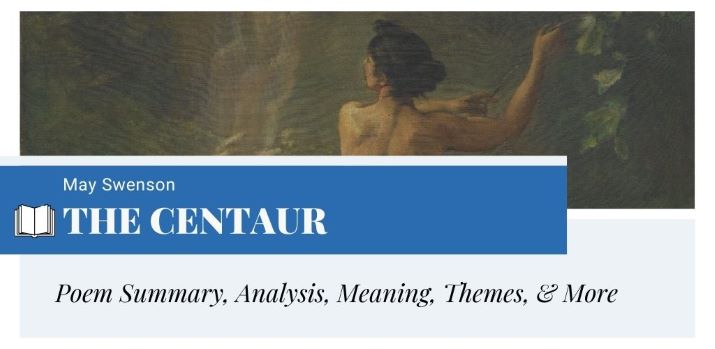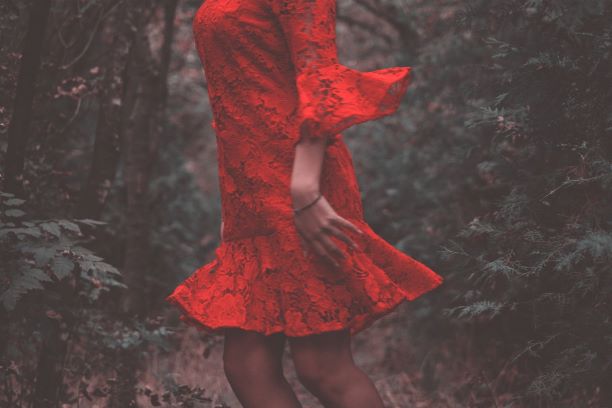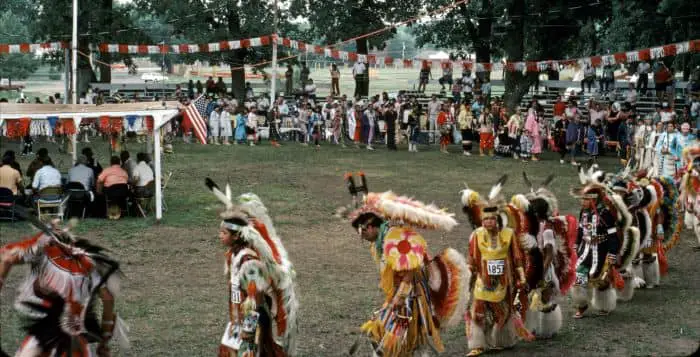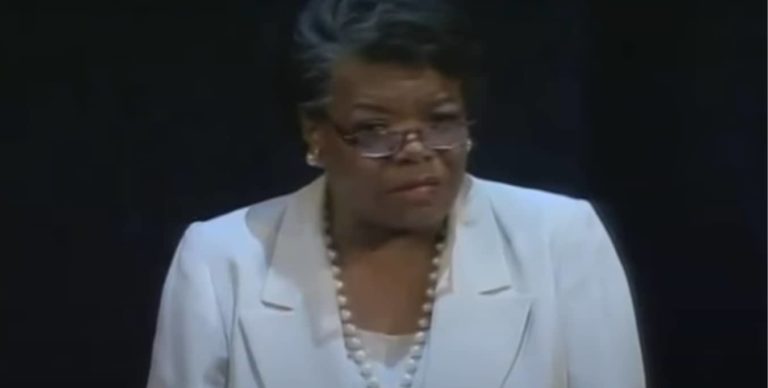The Centaur by May Swenson
“The Centaur” is written by one of the most important and original 20th-century American poets, May Swenson. She is mostly famous for her works for children and her poetry collection, Iconographs published in 1970. This poem appears in her second book of poetry, A Cage of Spines (1958). In this beautiful poem, Swenson shares her childhood story concerning how she spent her summer days riding a twig-horse and thinking she was a horse herself. It was a time when she was free from all the tensions and was being herself as she later remarked about her motto in life. Readers who have similar childhood experiences (most of them surely had) can connect with this piece better and relive their glorious, innocent past.
- Read the full text of “The Centaur“

Summary
“The Centaur” presents a little girl (the poet May Swenson herself) who played with a wooden stick imagining it to be a horse. She would go out each day in the willow grove nearby and make her a stick horse with her brother’s jack-knife. It was like a real horse. She fastened her brother’s leather belt on the knob of the twig and rode it along the way.
Now as a mature lady whenever she imagines those days she can feel the same thrill she felt on those days. Throughout the poem, the speaker goes on to describe her ride. In the end, when she returned home with her dirty dress, her mother asked her why her mouth was all green. Interestingly, she replies that her pet “Rob Roy” pulled some clover as they crossed the field. She ate some clover along with her imaginary horse.
Meaning
The title of this piece “The Centaur” is interesting to decode. First of all, a centaur is a mythical creature having the lower part of a horse and the upper part of a human. In classical Greek myths, the creature was mentioned as being wild and untamed.
Why does May Swenson describe her childhood self as a centaur?
She does so to depict the thinking pattern of the little girl. When she played with the wooden stick by thinking of it as her pet horse “Rob Roy”, she started acting like a horse. She says, “I was the horse and the rider”. It signifies that she felt herself to be both a rider and a horse. She imagined her legs as the hoofs of a horse and her head was that of a rider. That’s why Swenson refers to a centaur in the title. This centaur is a metaphorical reference to her childhood self while she rode the wooden stick. Besides, she also acted like an untamed centaur while playing.
Form, Rhyme Scheme, & Meter
May Swenson wrote her poem “The Centaur” in free-verse. It consists of three-line stanzas or tercets. A total of 20 tercets and a quatrain makes up the poem. There is no specific rhyme scheme except some occasional rhymings. For example, the first and third lines of the first stanza rhyme together.
The overall poem is told from the perspective of a first-person speaker who is the childhood self of Swenson. For this reason, it is an example of a lyric poem. The structure of lines also has a lyrical pattern
Regarding the meter of the text, it is composed of the iambic trimeter and iambic tetrameter alternatively. There are a few metrical variations as well. Let’s have a look at the scansion of the following excerpt from the poem:
The sum/-mer that/ I was ten —
Can it/ be there/ was on/-ly one
sum-mer/ that I/ was ten?
It must/ have been/ a long/ one then —
each day/ I’d go/ out to choose
a fresh horse/ from my stable
Poetic Devices & Figurative Language
Swenson makes use of several literary devices in the text that makes her childhood story more appealing to readers. Let’s explore the important poetic devices present in the text.
Metaphor
In this poem, “a fresh horse” is a metaphor of a willow twig and the “stable” is a metaphor of a willow grove. The speaker imagined the wooden twig to be a horse while riding on it. In the line “I was the horse and the rider,” the speaker metaphorically compares herself to both a rider and a horse. Throughout this piece, readers can find such metaphors using which she compares the parts of her body and the twig to that of a horse.
Enjambment
Swenson uses this device to make readers quickly read all the lines of a particular section in one go. For example, it occurs in the second and third tercets.
… have been a long one then—
each day I’d go out to choose
a fresh horse from my stable
which was a willow grove
down by the old canal.
A reader has to read one line after another to grasp the poet’s idea. This device connects those lines internally and maintains the overall flow of this piece.
Simile
It occurs in the following lines:
- “My head and my neck were mine,/ yet they were shaped like a horse.”
- “My hair flopped to the side/ like the mane of a horse in the wind.”
In the first example, the speaker compares her neck to that of a horse.
The next example contains a comparison between her hair and a horse’s mane. In both of these examples, Swenson uses the word “like” to compare two different things.
Alliteration
Readers can find the repetition of similar sounds in the following examples:
- “The summer that”
- “fresh horse”
- “was a willow”
- “long limber”
- “his head”
- “that talcumed”
- “his hoofs,/ hiding”
- “my toes, and turning”
- “shied and skittered”
- “my mane,/ my mouth”
- “sat on my steed”
- “linoleum/ left,” etc.
These repetitions within the lines create internal rhyming.
Polysyndeton
Swenson uses polysyndeton in the following lines:
- “I shied and skittered and reared,/ stopped and raised my knees,/ pawed at the ground and quivered.”
- “I was the horse and the rider,/ and the leather I slapped to his rump”
The repetition of the conjunction “and” creates a sense of continuity and connects the different actions that happened successively.
Inversion
The regular order of sentences is often inverted in poetic language. Let’s have look at a few of such examples from the poem:
- “Doubled, my two hoofs beat/ a gallop along the bank,”
- “Dismounting, I smothered my skirt/ and entered the dusky hall.”
- “My feet on the clean linoleum/ left ghostly toes in the hall.”
Onomatopoeia
Swenson uses some words to convey the sounds a horse makes. While some words convey the sounds that originate while riding a horse. Let’s explore where Swenson uses onomatopoeia.
- “I shied and skittered and reared,”
- “pawed at the ground and quivered.”
- “and swished through the dust again.”
- “spanked my own behind”
- “Doubled, my two hoofs beat“
- “the wind twanged in my mane”
Allusion
Swenson’s poem “The Centaur” contains an allusion to a Greek mythical creature. This creature has the body of a horse and the head of a human being. As a child, when she played with a wooden stick thinking it to be a horse, she acted like a horse and also as a rider. In this way, she became a creature like a centaur in her imagination.
The poem also contains an allusion to “Rob Roy”, a Scottish folk hero. Swenson’s speaker named her horse after him. As a child, she was also non-conforming to the things that were done by other girls. She played with a stick imagining herself to be an adventurous rider like Rob Roy.
Line-by-Line Analysis & Explanation
Lines 1-4
The summer that …
… a long one then —
The first line of May Swenson’s poem “The Centaur” introduces the speaker and context. Swenson opts for the first-person point of view for detailing the story. This speaker is none other than the poet herself when she was ten years old. At this age, girls generally enter into the stage of puberty. It is a critical age biologically as a girl starts to develop sexually. She comes across a wide array of physical impulses unknown to her before. It leads her to explore more about her body.
Whatsoever, there are no such references that make us think more about such biological concepts. In the upcoming lines, Swenson somehow links such concepts. Therefore it is better to give a glimpse of this concept.
In the first tercet, the speaker asks a rhetorical question. She asks whether there was the only summer when she was ten years old. Naturally, the answer is no. This line refers to the fact that the speaker made the most of her summer holidays.
Lines 5-9
each day I’d go out …
… my two bare feet.
As a child, Swenson would go out to choose a “fresh horse” from her stable. The term “fresh horse” clarifies that the speaker is not referring to an actual horse. In the following lines, she says that her stable was a willow grove. It was situated by the old canal. From this reference, it is clear that she is talking about a stick-horse made out of a fresh twig of a willow tree.
Swenson enjambs lines five to eight to quicken the pace. In the last line of this section, the speaker says that she would go out on her two bare feet. What does it mean? It is a reference to the nature of the speaker. She was like an untamed horse. To feel the ground under her feet, she went out barefoot.
Lines 10-16
But when, with my …
… head for a rein,
What did she do after leaving her house? She would take her brother’s jackknife (a kind of small folding knife) with her. Then she headed straight towards the willow grove and started finding fine, long twigs to make her horse out of it. After finding one, she used the knife to shape the twig into a long, limber horse. “Limber” means flexible and nimble.
She chose a twig that had a thick knob imagined as the head of her horse. Then she peeled off the rough and uneven parts of the twig and made it look slick and clean. She left a few leaves at the end of the twig untouched. The rear part was imagined as a tail. She also took her brother’s belt along with her. The child fastened the belt beneath the knob of the twig. It was used as a rein.
Swenson’s use of picturesque language helps readers to imagine the scene, step-by-step. Besides, there is an alliteration of the “b” sound in “brother’s belt”. It is also important to note the use of metaphorical language. For the speaker, the twig was not an inanimate object. It was a living horse for her. She groomed it in preparation for her ride.
Lines 17-22
I’d straddle and …
… swift half-moons.
From this section, the ride begins. In her childhood, Swenson would ride the groomed twig thinking it to be a horse. She uses the terms such as “straddle” and “canter” to give the lines a feel of horse riding. Straddle means sitting with one leg on either side. Canter is a variation of a horse’s gait.
The speaker made her imaginary horse run faster up the grassy bank to the dusty path. She speaks in a manner that seems like she turned into a horse. It is visible in this line “trot along in the lovely dust”. This line means she trotted along the dusty path with her wooden horse.
While trotting, the twig touched the ground. Dust covered it as well as the feet of the speaker. She says that the dust “talcumed” the horse’s hoofs. If she is comparing herself to a horse, the “hoofs” are a metaphorical reference to her feet. As she uses the pronoun “his”, it can also be a reference to the twig-horse. Swenson might have found masculinity in her childhood self.
The scent of the dust was so soothing to her as if it smelt like talcum. In the following lines, she says when she ran, the twig moved in the shape of “half-moons”. Here, Swenson uses visual imagery to describe a kinesthetic image.
Lines 23-30
The willow knob …
… a horse in the wind.
While trotting, the willow knob tied with the strap jounced between her thighs. As she jumped, the twig also moved upwards. She thought it to be the pommel. A pommel is the upward curving of the saddle in front of a rider. In the following line, she remarks that it was her pony’s head. Here, readers can find the comparison between the twig’s knob to the head of a pony.
She became so engrossed in her imagination that it seemed her head and neck had transformed into that of a horse. When she ran swiftly it made her hair flop in the wind like a horse’s mane. In this way, Swenson describes how she imagined herself to be a horse while playing with the twig.
Lines 31-40
My forelock swung …
… my own behind.
In these lines of “The Centaur”, Swenson’s speaker continues the description of herself while she rode her imaginary horse. According to her, her forelock swung in her eyes, and her neck arched. She snorted like a horse. Here, the verb “snorted” resonates with the actual snorting sound made by a horse. So, it’s a use of onomatopoeia.
A horse stops suddenly by seeing something standing between its path. She also “shied, and skittered, and reared” like a horse. The repetition of the conjunction “and” is used for the sake of emphasizing the verbs “shied”, “skittered”, and “reared”.
She stopped and raised her knees like a horse standing on its hind legs. Then she pawed at the ground and quivered, imitating a horse’s gestures. The following line similarly describes how the child swished through the dust by showing her teeth.
According to her, she was both a horse and its rider. The stick was just a medium to showcase her untamed self. Swenson’s portrayal of her childhood self reveals her wild, carefree, and spirited nature. Her poetic persona quickly shifts from being a horse to a rider and informs readers about the movement of her leather rein. As she slapped the belt to the twig’s imaginary rump, humorously it spanked her own behind.
Lines 41-48
Doubled, my two …
… hugging his ribs.
When a rider spanks a horse, it makes the creature run faster. The same thing happens with our speaker. Being beaten by her own strap, she doubles her pace. While running, her feet beat harder on the ground. It sounded like a horse beating its hoofs against the ground.
She galloped along the bank and the wind twanged her “mane”. The term “twang” is associated with the sound of a stringed instrument. It seems as if her hair was like the strings of a musical instrument and the wind twanged it. Here, Swenson personifies the wind and metaphorically compares the speaker’s hair to the strings of a musical instrument.
She sat on her metaphorical steed quietly, enjoying her ride. The ride made her forget about who she was or where she was. All she thought was that she was a rider and a horse. Being negligent of reality, she rode and rode. Her toes stood on the imaginary stirrups (a pair of devices attached to each side of a horse’s saddle to support a rider’s foot) and her thighs tightly hugged its ribs.
Lines 49-54
At a walk we drew …
… toes in the hall.
Swenson’s poem “The Centaur” nears its end as the speaker is now preparing to return to her home. She drew the twig-horse to the porch and tied it to a paling. Then she dismounted and smoothed her skirt. Swenson uses a metaphor in the following line. She uses the term “dusky hall” to refer to the time of dusk. It means she played all day long and returned home at dusk. The term also depicts the dim lighting in the hall at dusk.
When she entered the hall, her feet left “ghostly toes” on the clean linoleum. The quoted phrase depicts the dusty foot marks left on the linoleum.
Lines 55-64
Where have you been? …
as we crossed the field, …
In the last section of “The Centaur”, Swenson describes the conversation between the speaker and her mother after she returned home. Her mother could sense her daughter’s movement across the hall. Every mother can. She asked her about her whereabouts. She quickly replied with only two words “Been riding” as she was washing her face at the sink.
For the weight of her brother’s jack-knife, her dress was stretched awry. Her mother asked her about that and she replied that she had her knife. Thereafter her mother told her to tie back her hair.
Interestingly, her mouth was all green. It made her mother curious to know what happened to her mouth. In reply, she said that her imaginary horse “Rob Roy” had pulled some clover as they crossed the field. It means she ate the clover imagining herself to be a horse.
The reference to the Scottish folk hero “Rob Roy” is important to note here. It reveals the fact that the speaker was impressed by the character’s non-conforming attitude and named her imaginary horse after him. Like him, she was also a nonconformist to the stereotypes of society.
Themes
May Swenson’s poem “The Centaur” taps on the themes of childhood fantasy, horse riding, non-conformity, and wildness.
Childhood Fantasy
This poem is all about childhood fantasy and imagination. The speaker of this poem is Swenson herself. She talks about how she imagined a twig to be a horse. It became a thing while she rode on it by fastening her brother’s belt around its knob. Besides, she also fancied herself as a horse and imitated each movement a horse makes. Even she tried to sound like a horse and eat clover. In this way, the poem features the theme of childhood imagination.
Horse Riding
Another important theme of this poem is horse riding. As a child, Swenson was fascinated with horse riding. Those who are familiar with this game, find it quite amazing. The poet uses vivid imagery to depict this theme. She employs jargon related to horse riding to realistically depict how she rode her imaginary horse. For example, these lines reflect the theme:
I’d straddle and canter him fast
up the grass bank to the path,
trot along in the lovely dust
that talcumed over his hoofs,
Nonconformity
The theme of nonconformity is present in the nature of the speaker. Swenson was not fond of the things that the girls of her age preferred. She imagined herself to be a horse and sometimes a rider. While she played, she did not care about what others were going to think of her. Besides, she named her horse after the character of Rob Roy. It also depicts that she might have been fond of the nonconformist attitude of the folk hero.
Wildness
The way the girl played with her wooden stick reveal her wild self. Her spirit was not tamed. That’s why when she rode the twig, she did not only imagine herself as a rider. Rather she became the horse and acted as a horse does. She tried to imitate the creature’s wildness through her actions. That’s why by the end of the poem, readers find that she even tried to taste the clover playfully.
Tone & Mood
The tone of “The Centaur” is playful, imaginative, light-hearted, and fearless. Swenson maintains the tone throughout the piece. She uses a playful tone in the beginning and it is sustained in the following lines. Besides, she uses a fanciful tone to describe how she thought as a child. Her poetic self is filled with imagination. She can quickly play the roles she assigned to herself during playing. Apart from that, the lighthearted tone of this piece depicts the internal world of a child. A child remains lighthearted and fearless while playing. This piece also reflects this tone.
Imagery
Let’s have a look at different types of imagery used in “The Centaur”:
Visual Imagery
Swenson employs several visual images to vividly depict how she rode the twig imagining it to be a real horse. Readers can find the use of visual imagery in these lines:
- “which was a willow grove/ down by the old canal”
- “and peeled him slick and clean/ except a few leaves for the tail”
- “his feet to swift half-moons.”
Auditory Imagery
The poet uses auditory imagery in these lines:
- “trot along in the lovely dust”
- “I shied and skittered and reared”
- “pawed at the ground and quivered”
- “the wind twanged in my mane”.
Kinesthetic Imagery
The images depicting motion are present in the following lines:
- “I’d straddle and canter him fast”
- “jouncing between my thighs”
- “stopped and raised my knees”, etc.
Olfactory Imagery
Readers can find the images conveying specific smells in the following examples:
- “a fresh horse from my stable/ which was a willow grove”
- “that talcumed over his hoofs”
Organic Imagery
Swenson uses organic imagery to make her readers feel what her speaker felt while she went riding her horse. The use of this type of imagery is present in the following lines:
- “a fresh horse from my stable”
- “and peeled him slick and clean”
- “that talcumed over his hoofs,/ hiding my toes, and turning”
- “my mouth squared to the bit.”
Tactile Imagery
The images associated with the sense of touch can be found in the following lines from the text:
- “and peeled him slick and clean”
- “trot along in the lovely dust”
- “jouncing between my thighs”
- “My hair flopped to the side/ like the mane of a horse in the wind.”
- “My forelock swung in my eyes,”
- “spanked my own behind”
- “the wind twanged in my mane”
Historical Background
May Swenson’s “The Centaur” first appeared in the poetry collection, A Cage of Spines published in 1958. Much of the poet’s works are written for children. This poem is an ideal children’s poem in which she features how she became a horse as well as a rider through her imagination. The depiction is so picturesque that it makes readers imagine themselves in the saddles of the speaker. “The Centaur” was later published by Utah State University with vivid illustrations by Sherry Meidell. It was published digitally in 2007.
Questions & Answers
The title of this poem refers to a Greek mythical creature. Its upper body is that of a human and the lower part is that of a horse. When the speaker rode a twig imagining it to be a horse, she imagined herself to be a rider and also a horse. In this way, she transformed into a centaur.
May Swenson’s poem “The Centaur” was written around 1955. It was first published in her poetry collection, A Cage of Spines in 1958.
This poem is about how the poet imagined herself to be a horse and a rider while she rode a willow twig.
Swenson’s “The Centaur” centers on the themes of imagination, childhood, horse riding, and wildness.
The narrator of this piece is the poet May Swenson herself. She speaks in this poem from the perspective of a first-person speaker.
The tone of this poem is lighthearted, jocund, playful, and imaginative.
Similar Poems about Childhood
- “Fear” by Gabriela Mistral – It’s about a mother’s concern of her child’s future.
- “When I Was Fair and Young” by Queen Elizabeth I – It’s about a speaker who was courted by several men when she was young and how she suffers for love.
- “The Wind” by Robert Louis Stevenson – It’s all about a little child’s thoughtful description of the mighty and omnipresent wind.
- “When my play was with thee” by Rabindranath Tagore – This poem describes how the poet played with the almighty in his childhood.
External Resources
- “The Centaur” by May Swenson illustrated by Sherry Meidell — Check out the illustrated version of the poem published by Utah State University.
- Definition and Characteristics of a Centaur — Learn about the mythical creature and how it appeared in different mythological stories.
- About Rob Roy MacGregor — Learn more about the Scottish outlaw and folk hero.
- About May Swenson — Read about the poet’s life and her poetic works.
- Poet Profile & Poems of May Swenson — Explore the poet’s profile and read some of her well-known poems.






